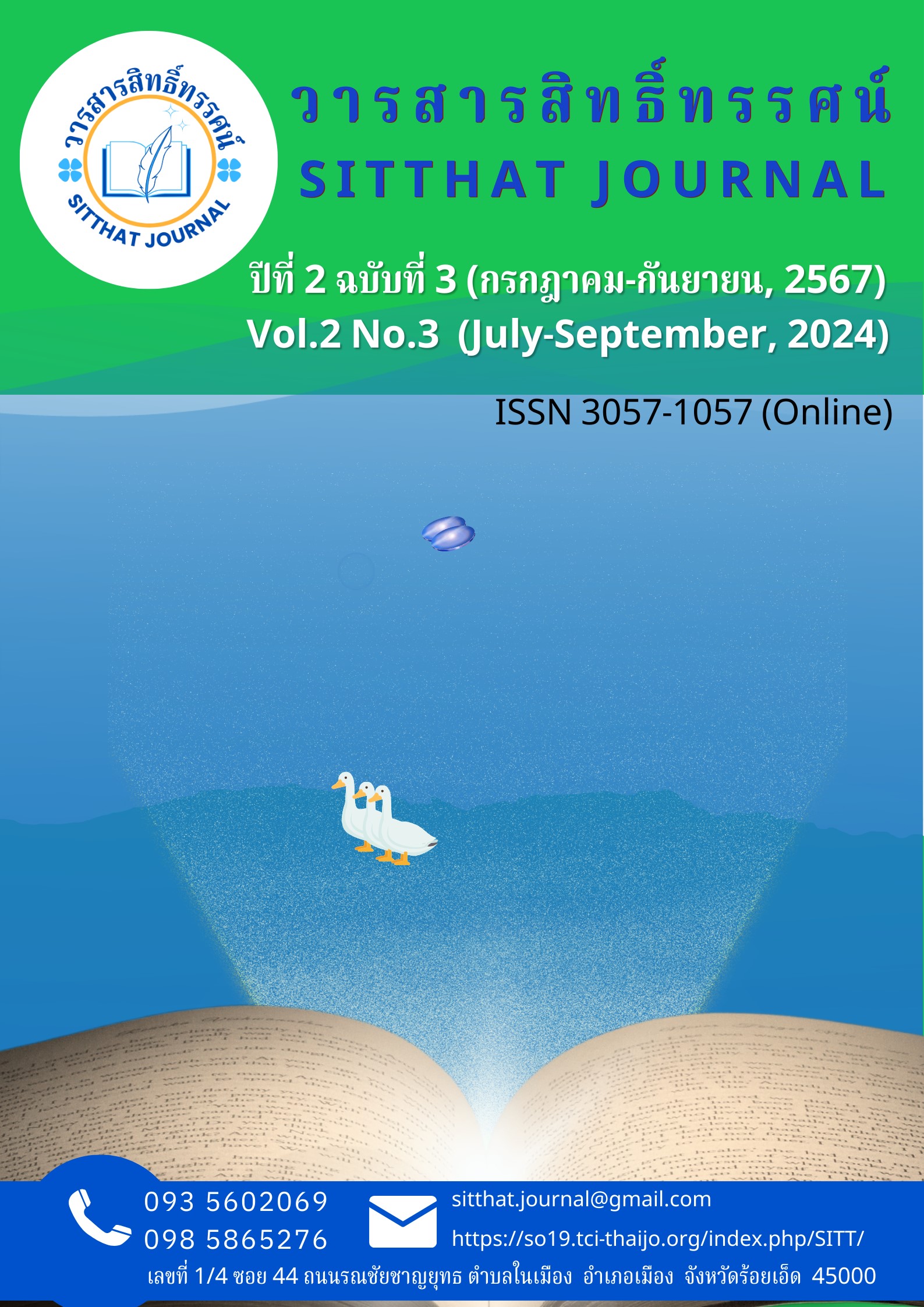GUIDELINES FOR DEVELOPING HUMAN POTENTIAL IN CHATUCHAK DISTRICT, BANGKOK
Main Article Content
Abstract
The objectives of this research are: 1) to study, analyze and synthesize guidelines for developing human potential in Chatuchak District, Bangkok. 2) To study the level of guidelines for developing human potential in Chatuchak District, Bangkok 3) To suggest guidelines for developing human potential in the district Chatuchak Bangkok How to conduct research Bangkok This research is a quantitative research (Quantitative Research) by using questionnaires (Questionnaire) who provides important information (Key Informants) regarding the development of human potential.
The research results found that
Most of the respondents were female, 220 people, or 55.00 percent, and 180 were male, representing 45.00 percent, respectively. There were people aged between 26-40 years, 132 people, or 33.0 percent, followed by People aged 41-50 years, 92 people, accounting for 23.0 percent. Next are people aged 25 years and under, 76 people, accounting for 19.0 percent next are people aged 51-60 years, 70 people, accounting for 17.5 percent, and few. The most is People over 60 years old, 30 people, accounting for 7.5 percent, respectively. Respectively, there were 180 people with less than a bachelor's degree level, accounting for 45.0 percent, followed by a bachelor's degree with 138 people, accounting for 34.5 percent, and a post-graduate level with 82 people, accounting for 20.5 percent, respectively. General contractors, 242 people, accounting for 60.5 percent, followed by private business occupations, 86 people, accounting for 21.5 percent, and government officials, 72 people, accounting for 18 percent, respectively, with incomes in the range of 25,001 - 30,000 baht, 147 people. Person Accounting for 36.75 percent, followed by those in the range of 30,001 baht and above, 121 people, accounting for 30.25 percent, next are those with incomes less than 15,000 baht, 70 people, accounting for 15.5 percent, respectively, and the lowest are those there were 62 people with incomes in the range of 15,001 - 25,000 baht, accounting for 17.5 percent.
The average level of the condition of the guidelines for developing human potential in all 4 areas is equal to 2.38, the S.D. value is equal to 0.82, the result is considered to be at a low level. The average level of potential development is equal to 2.52, the S.D. value is equal to 0.98, the result is considered to be at a moderate level. Second is the level of development of human potential. The mean value was 2.46 and the S.D. value was 0.75. The results were considered to be at a moderate level. Next is the development guidelines The mean value was 2.30 and the S.D. value was 0.65. The results were considered to be at a low level. And the aspect with the lowest average is the approach to developing human potential. The mean value was 2.24 with an S.D. value of 0.65, indicating that the results were at a low level.
The average level of human potential development in all 5 areas was equal to 3.04, the S.D. value was equal to 0.75, the results were interpreted as being at a moderate level, with the aspect of human adjustment having an average value of 3.20, the S.D. value was equal to 0.81, and the results were considered to be in High level. Next is human potential. It has a mean value of 3.14, an S.D. value of 0.78, which can be interpreted as being at a high level. Next is performance in humans. The mean value was 3.09 and the S.D. value was 0.85. The results were considered to be at a moderate level. Next is progress in humans, with a mean value of 2.93, an S.D. value of 0.72, which can be interpreted as being at a moderate level and the side with the lowest average is In terms of changes in humans, the mean was equal to 2.85, the S.D. value was equal to 0.62, the results were considered to be at a moderate level.
Article Details

This work is licensed under a Creative Commons Attribution-NonCommercial-NoDerivatives 4.0 International License.
บทความนี้
References
กัลยา วานิชย์บัญชา. (2560). การวิเคราะห์สถิติชั้นสูงด้วย SPSS for Window. พิมพ์ครั้งที่ 12. กรุงเทพมหานคร: ห้างหุ้นส่วนจํากัด สามลดา
ณัฐกุล ภูกลาง. (2561). การพัฒนาศักยภาพการปฏิบัติงานของเจ้าหน้าที่บริหารงานทั่วไปในมหาวิทยาลัยราชภัฏมหาสารคาม. รายงานการวิจัย, มหาวิทยาลัยราชภัฏมหาสารคาม
ธนาภรณ์ บุญทอง. (2561). การพัฒนาศักยภาพในการทํางานของบุคลากร กรณีศึกษา กองสถานที่ยานพาหนะ และรักษาความปลอดภัย สํานักเลขาธิการนายกรัฐมนตรี. โครงการรัฐประศาสนศาสตรมหาบัณฑิต มหาวิทยาลัยรามคําแหง.
ธัศฐ์ชาพัฒน์ ยุกตานนท์. (2560). แนวทางการพัฒนาศักยภาพผู้ประนีประนอมของศาลยุติธรรมกรณีศึกษา : ศาลแรงงานภาค 2. ดุษฎีนิพนธ์ (ปร.ด.) มหาวิทยาลัยบูรพา.
ธัศฐ์ชาพัฒน์ ยุกตานนท์. (2565). กระบวนการไกล่เกลี่ยข้อพิพาทโดยพุทธสันติวิธี ของศาลเยาวชนและครอบครัวกลาง. ดุษฎีนิพนธ์พุทธศาสตรดุษฎีบัณฑิต บัณฑิตวิทยาลัย มหาวิทยาลัยมหาจุฬาลงกรณ์ราชวิทยาลัย.
พัชรมน โตสุรัตน์. (2566). ปัจจัยด้านการพัฒนาศักยภาพบุคลากรที่ส่งผลต่อการเป็นระบบราชการ 4.0 ขององค์การบริหารส่วนจังหวัดราชบุรี. วารสารสังคมศาสตร์วิจัย, 14(2), 133 – 146.
วรินทร จินดาวงศ์, วันเพ็ญ วัฒนกูล. (2566). การพัฒนาและเสริมสร้างศักยภาพมนุษย์: แนวคิดและการประยุกต์หลักพุทธธรรม. วารสารสหวิทยาการนวัตกรรมปริทรรศน์. ปีที่ 6 ฉบับที่ 3 พฤษภาคม -มิถุนายน 2566
สาธินี หมัดสะและ. (2566). การพัฒนาทรัพยากรมนุษย์ที่ส่งผลต่อสมรรถนะการปฏิบัติงานของพนักงานบริษัทเจียไต๋. สารนิพนธ์หลักสูตรปริญญาการจัดการมหาบัณฑิต วิทยาลัยการจัดการ มหาวิทยาลัยมหิดล.
HREX.asia. (2562). การศึกษา (Education) สำคัญอย่างไรกับการพัฒนาทรัพยากรมนุษย์. สืบค้นเมื่อ 7 เมษายน 2566, จาก https://th.hrnote.asia/orgdevelopment/190625-education-for-hrd/


